#panopolis
Text
On Poimandrēs
The classical Hermetic literature (the Corpus Hermeticum, the Asclepius, the Stobaean Hermetic Fragments, etc.) generally take one of several formats: a monologue-type musing or speech (e.g. CH III or CH VII), a letter from a teacher to a student or between students sharing their wisdom (e.g. CH XIV or CH XVI), or a dialogue between a teacher and student (e.g. CH I or CH IV). By far the most…
View On WordPress
#amenemhat iii#coptic#Corpus Hermeticum#egyptian#greek#howard jackson#linguistics#ma`at#nimaatre#peter kingsley#poemander#poimandres#pymander#zosimos of panopolis
11 notes
·
View notes
Text




Zosimos of Panopolis, portrayed as an Alexandrian Scholar-Alchemist
by Midjourney v6
#Midjourney#Midjourney v6#Zosimus of Panopolis#Alexandria#Ptolemaic Alexandria#scrolls#alchemist#alchemy
2 notes
·
View notes
Text
i both love and hate nonnus. i dont know why he counts as a "classical source" when he's closer to medieval greece than he is to classical greece. hes from the 5th century common era. not before common era. hes literally from imperial rome... scholars love him and hate him. some people like him and some dont. most people do not. did you know that nonnus is the only source (that i could find) in which dionysus sexually assaults someone? yeah 💀 all him!
6 notes
·
View notes
Text
‘Let Atlas join the fight / let him break off mountains / launch them against the sphere of stars / he once carried on his shoulders / let the Seasons run in panic […] / Zeus son of Cronus / will heft the spinning mass of heaven / onto his own shoulders / the load of Atlas / and there he will stand / biting back his rancor.’
Tales of Dionysus, book 2, by Nonnus of Panopolis (tr. by William Levitan).
#Nonnus of Panopolis#Tales of Dionysus#Dionysiaca#Greek literature#tagamemnon#Atlas#Zeus#Typhon#this poem is dope I cannot for the life of me get over it
6 notes
·
View notes
Text
The Philosophers of Fire
One of the central concepts in alchemy was the idea of the four elements: earth, air, water, and fire, which were believed to be the basic constituents of all matter.
Among the alchemists, there were those who specialized in the element of fire, and they were known as the philosophers of fire. These alchemists believed that fire was the primary agent of change and transformation, and that it had…

View On WordPress
#alchemical symbolism#alchemist#alchemists#alchemy#fire#I was born in the fire#philosophers#philosophy#phoenix#purification#spirituality#sulfur#symbolism#the phoenix#transformation#zosimos#zosimos of panopolis
7 notes
·
View notes
Text
Timeline of Occult Figures
Here is a non-exhaustive list of people you will likely come across in researching anything under Occultism.
These dates are not going to be 100% accurate because many of these folks have either lied about their age or for some reason or another we don't have solid records of them.
---
Pythagoras 570-490 BCE
Socrates 470-399 BCE
Plato 424/5-348/7 BCE
Aristotle 384-322 BCE
Apollonius of Tyana 15-97 CE
Pliny the Elder 23/24AD-79CE
Ptolemy 100CE-170CE
Galen 129-216CE
Zosimos of Panopolis ~beginning of the 4th century
Roger Bacon 1220-1292
Henry Agrippa 1486-1535
Nostradamus 1503-1566
John Dee 1527-1608
Paracelsus 1593-1608
Jacob Grimm 1785-1863
Eliphas Levi 1810-1875
Helena Blavatsky 1831-1891
A. E. Waite 1857-1942
Margaret Murray 1863-1963
Aleister Crowley 1875-1947
Gerald Gardner 1890-1946
Robert Graves 1895-1985
Austin Osman Spare 1886-1956
Scott Cunningham 1956-1993
---
This is a re-upload because I can't find the original post I made so any additions made on that post have been lost. Please let me know if you have suggestions!
240 notes
·
View notes
Text
Dionysus' lesser-known myths [or perhaps you do know them, but i will tell you about them anyway]
Some of these myths have already been shown in my blog, but i decided to bring some of them up again in a more elaborated way, plus some new too. Perhaps you've heard of them, perhaps you haven't, but i can tell you i haven't seen them much around here.
And my job isn't reading your minds, it's about writting essays, so here we go.
1. Ampelos (Αμπελος):
According to Nonnus of Panopolis, Ampelos was a satyr (tho not many art represents him as such) who loved Dionysus, and was loved by him as well. Not much of a surprise, since we do know many gods had male lovers.
The problem is that, we're still talking about a satyr, we know how those guys are and act. According to Nonnus, Ampelos was riding a bull while mocking Selene, angrily, she sent a gadfly to sting the bull. The bull ran and threw Ampelos all over the place. Nonnus describes it as a very gore-like death.
Dionysus, upset, ended up turning Ampelos' corpse into a grape vine, and from there, he created wine with his blood... THANKFULY, it was the blood.
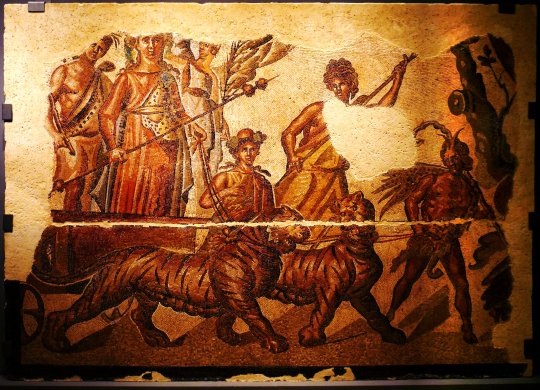
Roman mosaic with Ampelos and Bacchus.
2. Midas (Μίδας):
"But Nysus, everybody knows Midas" yes yes, but do you KNOW the actual Greek myths? Or do you know the later, VERY later-on version that appears in Wikipedia? Midas never turned his daughter into gold in the folklore, for example.
Midas was a foreign king who married a greek woman, he was the king of Phrygia, and according to Pausanias, he had a daughter named Zoe. I have absolutely nothing about her except this.
Anyways, going to the important part: Silenus, a companion of Dionysus who used to be one of his foster fathers, got lost while he was... Kind of drunk ( come on, Dionysus can't keep an eye on everyone 24/7 ). Some peasants found him and took him to King Midas, who, as a very loyal follower of Dionysus, recognized Silenus and took care of him. When Dionysus arrived in order to take him back, he thanked Midas and said he would give him in return anything that he wished for... And here it comes: Midas wished to be able to turn everything that he touched to gold, and Dionysus agreed, even though he felt sorry he hadn't thought of it twice.
Midas was happy turning stuff into gold, obviously. But when he touched food and it turned into gold as well and he was unable to eat, he returned to Dionysus asking him to turn it back to normal.
Surprisingly, Dionysus didn't say "no" or "live with the consequences"; he told him to wash himself in the river Pactolus, and, good enough, the gold thingy dissappeared.
I don't have this myth fully narrated by a Greek, instead, from a latin author. The good thing tho, thanks to Herodotus and Pausanias, i know it's realiable.

Monument dedicated to Midas, in the old Prhygia ( now part of Turkey )
3. The Minyades (Μινυάδες):
According to Plutarch, king Minyas had three daughters ( whose names i honestly don't know, they appear in Ovid's Metamorphosis ). He tells that Dionysus appeared in the form of a maiden to invite them to the Dionysian Mysteries, since the rest of the women had already gone there. And they declined, politely, but still declined. This is one of those moments in which we see Dionysus' weak points, no justified anger. They neglected the cult, but had nothing against it anyways.
Still, for him, that wasn't enough.
He drove them mad, like very. Something that for Plutarch was even worse than death, apparently. They even killed their own children and ate them (yikes) dismembering them like Dionysus was once dismembered. The sisters were wandering around the mountains, without Dionysus caring at all.
Until finally, Hermes took pity on them, and turned them into bats, freeing them from the madness.

One of the Minyades showing the dismembered body of her son - Étienne-Barthélémy Garnier
4. Zeus' lighting bolts
This one is short, so i'll get to the point.
We all know what Nonnus' was up to when writing about Dionysus. He said in his work that Zeus recognized him (when being Zagreus) as his heir. Since when he was still a little kid, he was able to climb to his throne and to hold Zeus' lightning bolts. Of course, then the very well-known myth of Hera calling the titants to dismember Dionysus arrives here, since she wanted no heir to the throne.
Things happen, you know.
5. Lykurgos (Λυκοῦργος):
Remember when i talked about this guy in the anger essay? Wellp, here he is again, it's the same, but i'll elaborate on him a bit more.
He was a thracian king, and when he heard that Dionysus was going to Thracia, he ordered to trap all of his female followers in a prison.
Yes, only the women. I guess no men followed Dionysus in Thracia during his reign, not like i can ask him about it.
OF COURSE Pentheus 2.0 would imprison the FOLLOWERS of the god of MADNESS. Of course...
Dionysus got angry ( what a surprise ) and sent a drought towards Thracia + making Lykurgos go mad. It's not Dionysus if he doesn't punish you by making you go mad.
He then proceed to tell the people that the only way to stop that punishment was by killing Lykurgos, and, well, they did. They all killed him, and were freed from the punishment.
Dionysus then stopped the drought, he kept his word, indeed.

Lykurgos attacking his own wife after being induced into madness
6. The punishment of the titans
You think they got away? No, the fuck, of course they didn't.
After Zeus' found out what had happened to Dionysus (Zagreus), he imprisoned them in Tartatus, which caused Gaia to be all sad again, since many of her children had already been imprisoned there. What she did was, as scary as Gaia has always been, burning down everything she could.
The only way Zeus could take pity on her in order to stop that, was by sending a flood.
7. Coresus (Κόρησος):
Callirhoe was a Calydonian woman who scorned Coresus, a priest of Dionysus, who threatened to afflict all the women of Calydon with insanity as the good Dionysus priest he was.
The way to stop this was with a sacrifice, to kill the woman who scorned him. Coresus was ordered to sacrifice her, but he killed himself instead since apparently, he was in love with her and couldn't do it.
Callirhoe was overcome with remorse, and cut her throat at a spring that later received her name.
As always.
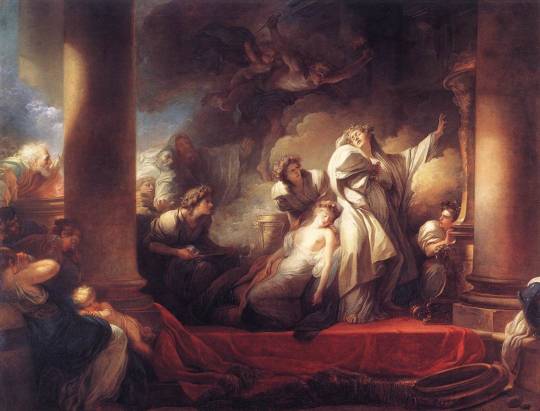
Coresus sacrificing himself to save Callirhoe - Jean-Honoré Fragonard
8. The Frogs (Βάτραχοι):
At this point, this isn't lesser-known anymore, and i'm not the biggest fan of Aristophanes' work (i love Euripides way too much, oops) but i'll still summarize what Dionysus has to do with this play.
Dionysus, as the god of theatre he is, wanted to bring back to life one of the great tragedy authors. And he descends to Hades for that, it's a way to mock his connection with it, this is still a comedy.
And after a poetry slam, Aeschylus is chosen in preference to Euripides. Smh, fucking Aristophanes, way to put your preferences.
9. Orpheus' death:
I'm not gonna elaborate on this one THAT much, since i wanna save it for the Apollo & Dionysus essay i have unfinished, which was the second most voted one and it might take more time to finish it.
In any case, do you know all these modern retellings in which they paint Dionysus as the "chill, calm, who only wants to party" dude? And Apollo as the "feral, envious, angry" dude? Well, ya'll are wrong...
Dionysus killed Orpheus due to his jealousy of Apollo's worship. I'm leaving you with this sentence, wait for the other essay to know why Dionysus and Apollo are so complex in terms of feelings. Or, at least, i will try to elaborate on it.
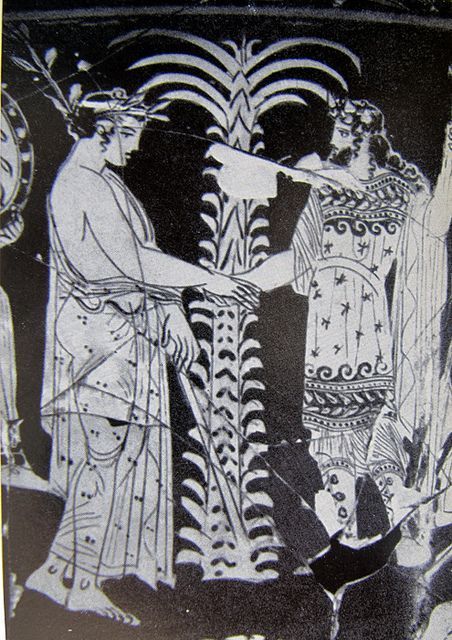
Apollo welcoming Dionysus to the sanctuary of Delphi, which they shared.
10. Dionysus IS physically incapable of getting drunk, live with it:
SHOCK i know. So if i see any of ya'll saying he's drunk 24/7, you better have your testament written.
NONNUS OF PANOPOLIS. DIONYSIACA. LITERAL TEXT: "Only to Dionysus gave Rhea the amethyst that saves the drinker from the chains of madness."
Yes, obviously going for scientifict facts, this doesn't work. It was believed in this world that the amethyst would prevent people from getting drunk. But this is mythology, Dionysus is a god, he can't get drunk even if he wanted to. And it's not like he should, he needs to keep an eye on his followers 24/7. Or do we want to remember what happened to Silenus?
Dude, how the hell do i have to tell you all, that in all text in which people were drinking for honoring Dionysus, they always stopped saying "he wouldn't like to see us this way" HE DOESN'T WANT YA'LL DO GET DRUNK. THAT'S NOT HOW HIS MADNESS WORKED
No. The women in the Bacchae are not ✨girlboss slaaaaay✨ they were feral women. The madness Dionysus used to punish Pentheus and the Theban women is NOT something you should idealize. Euripides didn't want ya'll to call him an icon because "omg the Bacchae is so progresive" GUYS... NO. IT'S NOT ABOUT THAT. It's about showing Dionysus' wrath. Of showing why like with any other god, he's feared.
The Greek gods are not your free playground OC's. You can't invent their sexualities or gender identities just for yourself. They're important figures of a culture and country that still lives. If you want an icon to feel identify with, create one. But don't go around there saying Dionysus is genderfluid JUST because you like seeing him young. No.
I know, personally, genderfluid people, and all of them agree THIS is wrong. I already had the whole pronouns drama with Dionysus, don't start over again with this. Please.
* AHEM * In any case... Hope you enjoyed !
I needed to work A LOT for this essay, since most of these myths weren't listed with sources. Whenever you wanna write a guide about folkore or anything similar, please, list your sources ! i don't want anyone else to go through the pain of needing to research though the catacombs of information JUST to confirm one sentence. Because i went trhough that, there's a reason why i've been researching about Dionysus for more than three years already and i still don't have everything. Thanks for your support and essay requests as always, it makes me INCREDIBLY happy to see so many of you willing to learn about a figure that has been so underappreciated and reduced into nothing like Dionysus, and who is still being misinterpreted to this day.
As always, reblogs would be very appreciated, it's the way people can find my blog for something else than copypaste incorrect quotes, and i always appreciate that kind of support. Of course i do this "por amor al arte" as i would say in Spanish, but still takes time and effort and i'm just a university student. I still will need A LOT of time to be able to work into something more accesible to everyone for the Greek folklore.
For now, this small Tumblr pieces is what i can give. But as always, thank you and χαίρε Διόνυσον 🍇
211 notes
·
View notes
Text

Ivory Pyx with the Triumph of Dionysos in India
Syria, Byzantine, mid-500s
Dionysos, a son of Zeus, rides in his chariot overseeing his conquest of India as described by the fifth-century Egyptian poet Nonnos of Panopolis: "Lord Bacchus [Dionysos] spoke…Indian slaying servants of invincible Dionysos! Bind them all fast unresisting, the sons of the Indians, take them all prisoners in bloodless conflict."
23 notes
·
View notes
Text
still thinking abt the concept of panopoly (panem monopoly)
7 notes
·
View notes
Text
just collecting data- please spread this for a larger sample size 😊😊😊
40 notes
·
View notes
Text

Sofia Coppola by Andrew Durham for the New York Times
Clockwise from top left, the taxidermy shop Deyrolle; strolling on Rue Jacob; confections at Gerard Mulot

Clockwise from top left: Bouquets on Rue de Tournon; Sofia Coppola on a shopping break; the Fontaine de Medicis, designed in 1624, in the Jardin du Luxembourg; Azzedine Alaïa's boutique

Clockwise from top left, at Goyard; in the Jardin du Luxembourg; a panopoly of shirting fabric at Charvet; an artwork by Lotta Hannerz in the Fontaine de Medicis; at the Clignancourt flea market

Being fitted for a dress by Azzedine Alaïa; at Le Voltaire; perusing the menu at Le Castiglione

Andrew Durham for The New York Times
Clockwise from top left: Flowers at Odorantes; Lanvin; fresh pastries at Ladurée; Sofia in a contemplative moment.
9 notes
·
View notes
Text
‘—But Zeus? / Sitting in silence, no cloud to call his own, and twiddling / His thunderless thumbs, completely deprived of his natural noise.’
Nonnus of Panopolis, Dionysiaca, book 1 (trans. Douglass Parker).
5 notes
·
View notes
Text
Goêtic Atavisms (pre-order)
It's hardback pre-order day, folks!
If you want in on one of the 500 fine edition hardbacks, head over to Hadean Press and pre-order here.
Now, for non UK folks, I suspect shipping may be pricey but keep an eye on folks like Miskatonic Books or similar if your're in NA. (I'll post here if I spot any) Shipping in July, and I suspect the paperback, which will also be available then may end up available through the Great Horror that is Amazon.
Until then, click through the links or enjoy this sneaky peek at the paperback cover, blurb and video!
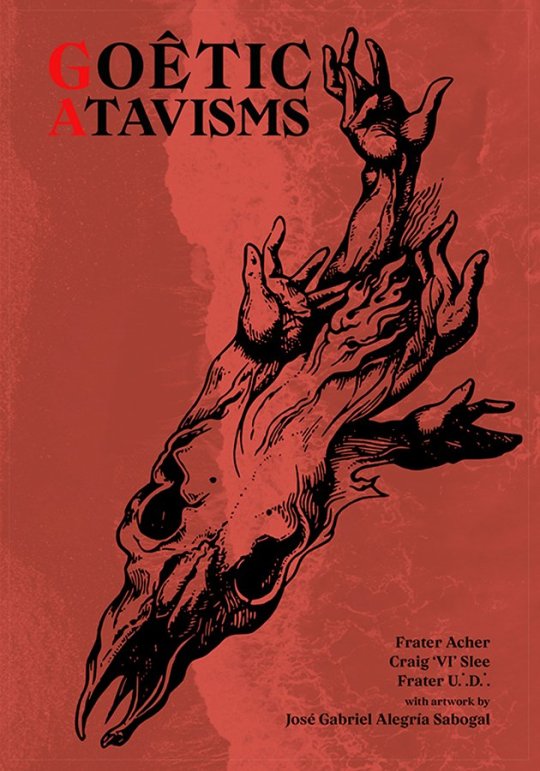
youtube
"Goêtic Atavisms is designed to be an uncompromising and challenging book.
Written in mutual exchange between practitioners Frater Acher and Craig Slee, two radical views and explorations of applied goêteia emerge. This tête-bêche book can be read from both sides; behind one cover containing the chapters by Acher, behind the other those by Craig Slee, and where they meet in the middle a preface by none other than Frater U∴D∴.
In their own unique voices, the authors draw the reader in and call on them to bring goêteia to life in their own flesh. Over twelve chapters, packed with historic detail and practical experimentations, the reader is guided to take a fresh look at such diverse bodies of goêtic work as Zosimos of Panopolis, Germanic and Old Iranian folklore, Goethe’s Faust and the Earth Spirit, Austin Osman Spare's œuvre, as well as modern forms of corporeality such as pornography, tattoo culture, and bodily disability. Goêtic Atavisms was written not only to be a sensual experience, but to facilitate magical touch."
61 notes
·
View notes
Text
Continuing on the POI rewatch (halfway through season 2!)
I absolutely forgot Greer showed up this early. The cyberpunk really does start from the word go.
Also I really thought Kara had longer before getting blown up.
You could write an essay, uh, irony(?) of the CIA plotline/Reese's unfinished business as a war-on-terror triggerman being tied off via suicide bombing.
Speaking of essay topics - this show really does make a fetish object of mens' suits as, like, iconic panopolies of professional-class masculinity.
18 notes
·
View notes
Text
MARY THE JEWESS // ALCHEMIST
“She was an early alchemist known from the works of Zosimos of Panopolis (fl. c. 300) and other authors in the Greek alchemical tradition. She is credited with the invention of several kinds of chemical apparatus and is considered to be the first true alchemist of the Western world.”

5 notes
·
View notes
Text
Women in Alchemy
Like many aspects of history, woman have been widely removed from the narrative of alchemy’s history. However, this false narrative hides the extraordinary impact that female figures had in the world of alchemical practices.
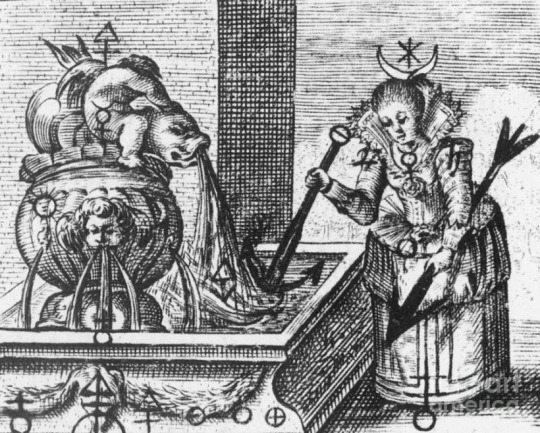
Michael Maier (German physician and counsellor to Rudolf II Habsburg, a notable alchemist) named women who were able to create the famed Philosopher’s Stone.
Mary the Jewess
A.k.a. Mary the Prophetess or Maria the Copt; Mary the Jewess was an early alchemist who became known from the works of Zosimos of Panopolis (Greco-Egyptian alchemist). On the basis of this work, Mary the Jewess lived between the first and third centuries A.D. in Alexandria. She is noted as one of the first alchemical writers, with her works not being dated later than the first century.
Mary is credited with the invention of multiple kinds of chemical apparatus, and is considered the first true alchemist of the Western world. She believed that metals had two different genders, and that if you were to join these two together a new entity could be made.
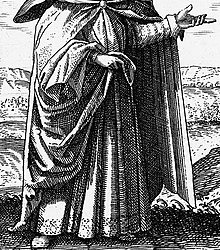
Axiom of Maria
One becomes two, two becomes three, and out of the third comes one as the fourth
Carl Jung notably used this axiom as a metaphor for individuation, and wholeness.
Inventions
Tribikos
An alchemical still (alembic) with three arms used to obtain substances purified by distillation
Still used today in chemistry labs
Kerotakis
Device used to heat substances used in alchemy, as well to collect vapors
Bain-marie
A.k.a. “Mary’s bath”
Limits the maximum temperature of a container and its contents to the boiling point of a separate liquid (essentially, it is a double boiler)
Cleopatra the Alchemist
A Greek alchemist and philosopher active in Alexandria during the 3rd or 4th century A.D. It’s notable that this is not Cleopatra VII, rather this is a pseudonym for an unknown author (or even a group of authors). Despite her hidden identity, Cleopatra the Alchemist is a foundational figure in alchemy, her influence perhaps even pre-dating Zosimos of Panopolis.
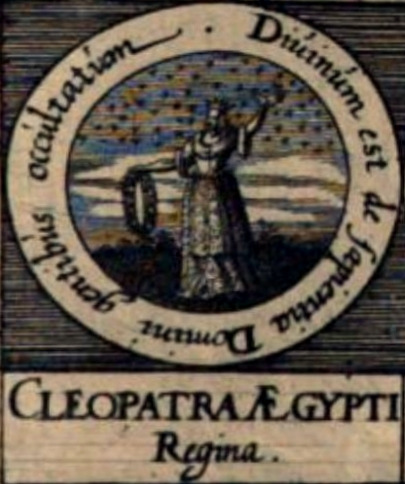
Cleopatra the Alchemist is most noted for the Chrusopoeia of Cleopatra, a lone sheet document containing only symbols, drawings and captions. Examples of the imagery seen are the Ouroboros, an inscription saying:
One is the Serpent which has its poison according to two compositions, and One is All and through it is All, and by it is All, and if you have not All, All is nothing.

There are also drawings of “dibikos”, an instrument similar to a kerotakis.
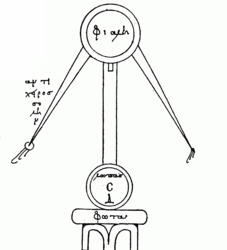
Another is a symbol of the eight-banded star, and many believe the drawing of these star symbols and the crescent shapes above them are a depiction of turning lead into silver.
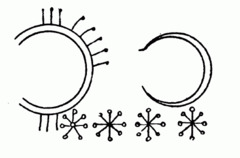
Paphnutia the Virgin
Living around the time of 300 C.E., Paphnutia was an Egyptian alchemist referred to in the letters between Zosimos of Panopolis and his sister, Theosebeia (also assumed to be an alchemist). Within these letters, Zosimos criticizes his sister for associating with Paphnutia, someone he considered to be uneducated and incorrect in her practice of alchemy.
Little else is known about her, aside from the possibility that she could have also been a priestess. It’s also theorized that she was connected to a school of alchemy that competed with that of Zosimos.

41 notes
·
View notes